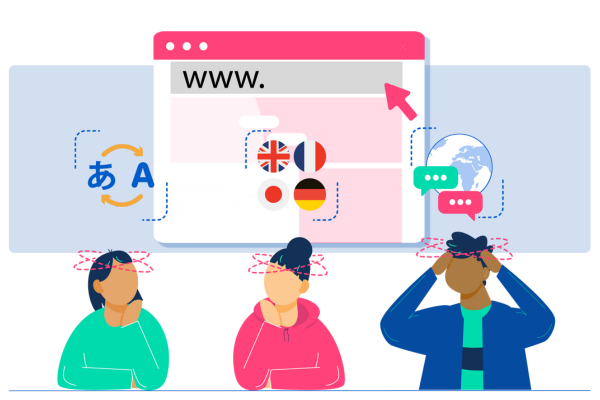Struggling to launch multi-language campaigns simultaneously due to a lag in content localisation time?… lost amongst localisation issues, not sure where to begin or just wondering how localised content can boost your business? Forrit can help.
If you want to:
- Boost CX and customer retention in other regions
- Launch new projects simultaneously across global markets
- Boost brand affinity and market share in recently-launched in territories
- Meet strict sector regulations around global content update times
… then localisation needs to be a part of your marketing strategy.
If you’re already on your way towards getting content localised, but need more efficient localisation processes to take the weight off your content team’s shoulders… you need a CMS with built-in translation and localisation tools.
When searching for your next content management system, localisation should be at the forefront of the features you look for, read on to see why.
What are the benefits of adopting a localised marketing strategy?
For those in highly-regulated industries, localising content can be crucial for meeting sector compliance requirements. For companies looking to branch out into other territories and expand their offering, having relevant, culturally-aware content can be make or break. To build an easy-to-navigate, engaging CX for global audiences and boost your brand’s reputation in other markets, localisation is essential.
Highly-regulated sectors such as the FSI, require frequent content updates to make sure the most up-to-date information is being shown to customers. Your customers in other regions could potentially be missing out on the latest versions of the information they need, due to slow or no localisation of your content.
These customers, or potential customers in other territories, could be missing out at awareness, interest and consideration stages about your great product or service, without localised content to draw them in, and provide more information. By having localisation at the heart of your marketing strategy, you can better connect with consumers around the world.
What kind of content can you localise with your CMS?
Along with localising the overall website experience your user in another region has, you may want to localise different types of content too, hosted within your CMS. Find below the benefits of localising not just web content, but blog posts, product offers and metadata too.
Blog posts: with a multi-site CMS you can easily host your blog within the same system as your website, making creating and publishing region-specific content easy. Blog posts are a great way to tell locally-relevant, engaging stories or case studies, featuring your product or service and are a great way to connect and engage with local audiences.
Web content: localising your website content means having content specific, correctly-translated, up-to-date and engaging for audiences in different locales, which in turn is likely to boost search, engagement and in time, conversions.
SEO content: going hand-in-hand with the above content types, is your site’s metadata and through it, the potential to rank organically for keywords relevant to audiences in different regions. By SEO optimising with localised metadata and keywords relevant in that locale, you improve your site’s chances of getting in front of the right customers in that region, organically.
What if my current CMS doesn’t have in-built localisation options?
Forrit’s latest whitepaper revealed that 25% of their FSI marketer respondents, don’t localise/translate content purely because their current CMS doesn’t support translation.
Choosing a content management system with in-built translation capabilities, or easy integration with translation APIs is crucial, to avoid time-to-market delays and workflow inefficiencies down the line. Additionally, take into consideration how long it takes to get this translated or localised content live, through the system.
Forrit One CMS’s built-in AI translation tools allow you to speed up the process, helping your in-house localisation team with quick locale go-live and content update times, meaning your global customers can get the accurate information they need, when they need it.

What if localisation is inefficient and takes too long through my current CMS?
In Forrit’s latest whitepaper, of the 250+ senior marketers spoken with, 49% said they don’t bother localising materials because it takes too long for content to be translated.
When choosing a new CMS, its localisation capabilities should be a focus of your search and not an afterthought. Cloud-native CMS, Forrit One, utilises Microsoft Azure AI technologies to automatically translate your content within your CMS - which can be left as is or sent for approval by your local team in that language, to alter the copy accordingly.
This means no integration inefficiencies between your CMS and translation software add-ons, or workflow disruption through back-and-forth with translation agencies. Outsourcing translation and manually uploading copy for each content block can be time consuming - so Forrit One utilising AI and having this in-built capability, is a great base to build upon.
What features should I look for in my next CMS, with localisation in mind?
When it comes to localising content, the CMS you opt for will be at the heart of the content localisation strategy you can implement. Choosing the right CMS is essential -
Forrit’s latest report revealed that 25% of senior FSI marketers are currently using a CMS that doesn't have built-in translation capabilities - meaning additional add-ons and translation services are necessary to put this strategy into practice… meaning more potential for security breaches, and a longer time-to-market.
Your CMS needs to be agile enough to support translation, leverage Cloud Services for quick and easy translation as a starting point and easily integrate with other tools if external localisation help is needed, further along in the process. Forrit One has just that, helping reduce translation time from days to weeks. Read on to see how this works.
How does Forrit One’s AI-driven translation tool help to localise content?
Forrit’s cloud-native CMS, utilises Microsoft Azure AI technologies to automatically translate/localise your content within your CMS - which can be left as is or sent for approval by your local team in that locale, to alter the copy accordingly. This means, no add-ons, no agencies, you can localise your content in-house - meaning no integration inefficiencies between your CMS and translation software, no workflow inefficiencies and no need for translation agencies.
Those that wish to work with an external translation partner, can still utilise Forrit One CMS, but a custom integration can be developed so that it can be easily integrated into the CMS for an efficient end-to-end localisation workflow.
Outsourcing translation and manually uploading for each content block can be time consuming and not seem worth the hassle - so Forrit utilising AI and having this in-built capability, is a great base to build from.
Explore localisation and other Forrit One CMS features.
Interested in learning more about how to improve customer experience? Read our article on the top ways to boost CX, with your CMS.
Want to find out what other CMS challenges senior marketers were facing whilst navigating the MarTech Maze? Download and explore the maze, here - Read our whitepaper.
Our latest blog articles
Create a top-quality customer experience.
Your CMS can supply the foundation for an outstanding customer experience.
Learn moreHow a CMS can improve ESG.
In recent years, we've seen ESG considerations shoot up the corporate agenda. Why the big fuss?
Learn moreThe CMO responsibility shift.
Business operating models have changed, and the C-suite is rapidly evolving alongside.
Learn moreA responsible CMS.
As the climate crisis moves higher up the media agenda, consumers are demanding action.
Learn more